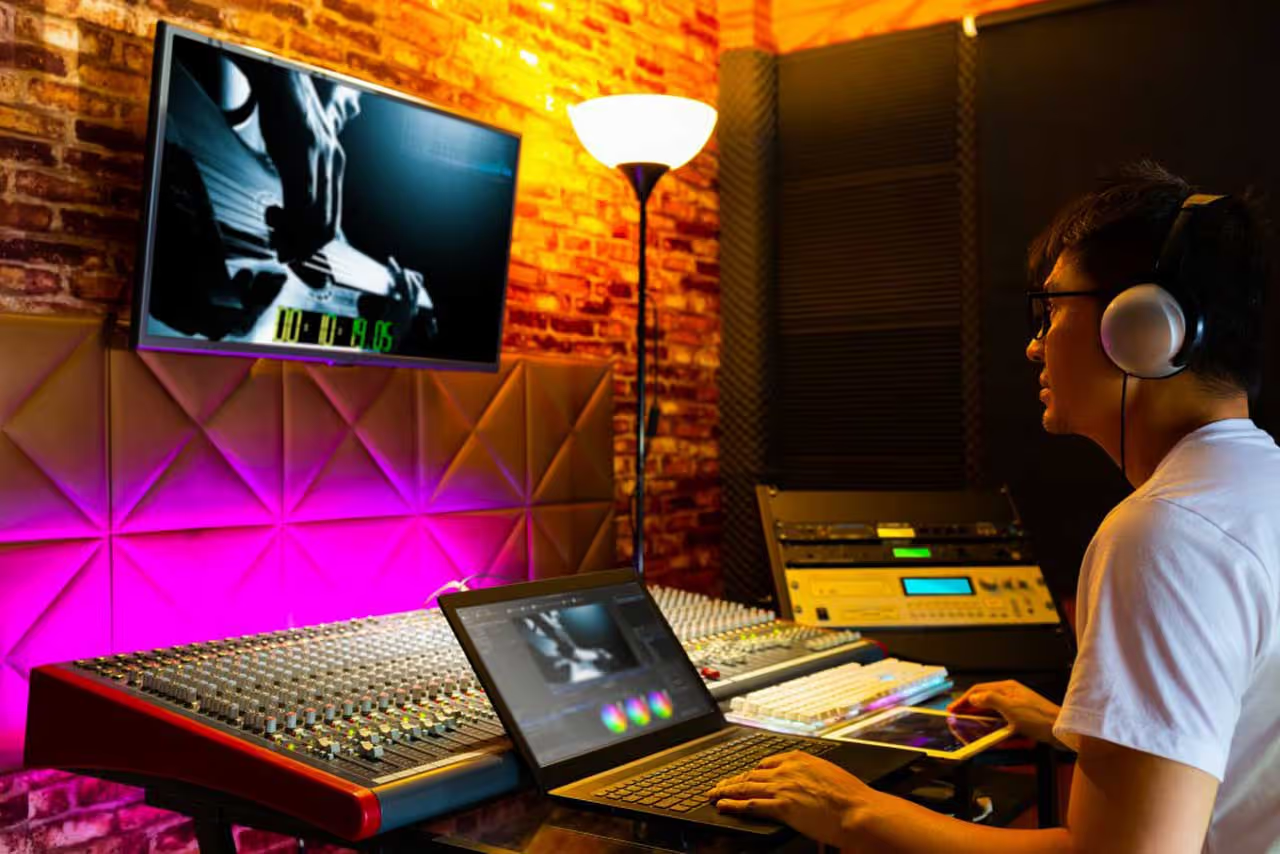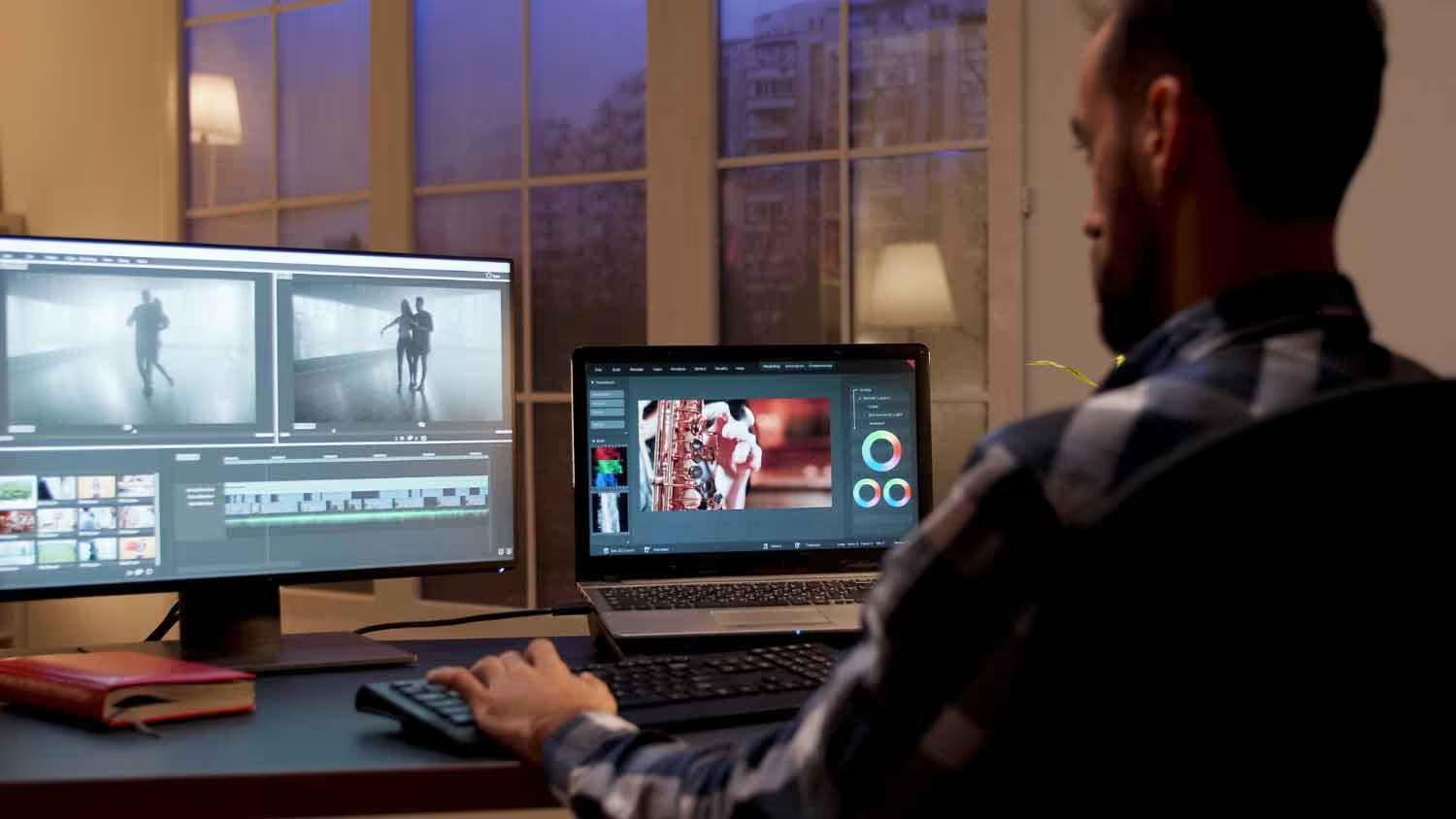Table of Contents
A successful video cannot be made only from raw video. Many processes that take place after filming are necessary for a well-produced video. This is the art of post-production, the final stage of making a video. After you have recorded your footage, the final touches need to be added to your film. Multiple individuals and teams maybe involved in the process, from editors and color graders to sound mixers and dubbing artists. Learn more about the process stages in our comprehensive guide.
Key Differences between Pre-production, Production and Post-production Video
Pre-production
Pre-production is the preliminary phase where the groundwork for a video project is laid. It involves careful planning, organization, and preparation before the actual filming takes place. This stage sets the foundation for a successful production and helps ensure that the project stays on track.
Production
This is the shooting phase. Scenes are captured on camera while they are happening. After each day, the footage is frequently recorded and saved to be sent as quickly as possible to the post-production crew. Depending on the length of a film and the amount of footage needed, some shoots can take days, while others can go on for months. Where required, voiceovers and sound will be recorded on-site.
Post-production
This final stage is when the film is formed as the actual product. Post-production is arranging, cutting, colors, and editing the footage shot in production. At this stage, itis certainly not only the editor who has an important role. There are sound engineers, dubbers, foley artists, online and offline editors, and many more. There is a cooperation between many parties that will improve a film or other audiovisual work.
Who is Involved in Video Post-production?
Video Editors
Editors are the architects of video post-production. They work closely with directors to shape the narrative, selecting the best shots, arranging them in a logical sequence, and trimming unnecessary footage. Editors have a keen eye for composition, pacing, and storytelling, ensuring a seamless flow that engages and captivates the audience. They collaborate with other professionals to refine the visual and auditory aspects of the video.
Colorist
Colorists are responsible for the art of color grading, which involves manipulating and enhancing the colors in a video to create a specific mood or atmosphere. The collaborate with directors and cinematographers to ensure consistency and enhance the visual tone of the project. Using advanced software and their creative sensibilities, colorists adjust brightness, contrast, saturation, and color balance to achieve the desired look, bringing out the emotional impact of each scene.
Sound Designers
Sound designers play a crucial role in creating a rich and immersive auditory experience in video post-production. They work with directors and editors to enhance dialogue, incorporate sound effects, and create a harmonious balance between various audio elements. By removing unwanted background noise, enhancing key sounds, and integrating a captivating musical score, sound designers help to reinforce the storytelling and evoke specific emotions in the audience.
Visual Effects Artists

Visual effects (VFX) artists are involved in post-production when it comes to adding or enhancing visual elements that cannot be captured during filming. They use computer-generated imagery (CGI), motion tracking, and compositing techniques to seamlessly integrate real footage with digital elements. VFX artists collaborate with directors and editors to create breathtaking visuals, from subtle enhancements to spectacular displays, unlocking creative possibilities that enhance the overall impact of the video.
Motion Graphics Designers
Motion graphic designers create animations, text, and graphics to add vibrancy and clarity to video content. They work closely with the directors and editors to design and animate elements such as the title sequence, the bottom third, and the informative graphics. Using software like Adobe After Effects, they bring static elements to life by combining motion, transitions, and visual effects, ensuring videos effectively convey key messages and capture and engage your audience with images.
Producers and Project Managers
Producers and project managers play an important role in video post-production by overseeing the entire process. They work with directors, editors, and other professionals to ensure projects stay on track, on schedule, and on budget. They facilitate communication between team members, manage logistics, and make key decisions that affect the final outcome of the video.
6 Essentials Elements of Video Post-production
Editing: The Art of Crafting Narratives
Editing is the heart of video post production. It involves selecting the best shots, arranging them in a logical sequence, and trimming unnecessary footage to create a seamless and engaging story. Skilled editors have a keen eye for composition, pacing, and timing, enabling them to evoke specific emotions and maintain the flow of the narrative. They work closely with directors and other creative professionals to shape the final product.
Color Grading: Setting the Visual Tone
Color grading is the process of manipulating and enhancing the colors in a video to create a specific mood or atmosphere. It plays a vital role in establishing the visual tone of a production. By adjusting brightness, contrast, saturation, and color balance, colorists can transform the raw footage into a cohesive visual experience. Whether it's a warm and nostalgic look or a cool and futuristic vibe, color grading helps to reinforce the intended emotional impact of the video.
Sound Design: Immersive Audio Experiences

Sound design encompasses all aspects of audio production in a video, including dialogue, music, sound effects, and ambient noise. It is responsible for creating a rich and immersive sonic experience that complements the visuals. Sound designers carefully balance different audio elements, removing unwanted background noise and enhancing key sounds to ensure clarity and impact. They also work with composers and audio engineers to integrate a captivating musical score that enhances the storytelling.
Visual Effects: Unlocking Creative Possibilities
Visual effects(VFX) have become an integral part of modern video production, allowing filmmakers to realize imaginative worlds and breathtaking visuals that are otherwise impossible to capture. VFX artists utilize various techniques, such as CGI (computer-generated imagery), motion tracking, and compositing, to seamlessly blend real footage with digital elements. From subtle enhancements to spectacular explosions, VFX add depth, realism, and visual flair to the final product.
Motion Graphics: Enhancing Information Delivery
Motion graphics involve creating animated visuals, text, and graphics that convey information or enhance storytelling. They are commonly used in title sequences, lower thirds, and informational graphics. Motion graphics designers use software like Adobe After Effects to bring static elements to life, incorporating movement, transitions, and visual effects. These dynamic visuals help engage viewers and effectively communicate key messages.
Video Compression and Delivery: Optimizing for Different Platforms
Once the post-production process is complete, the final video needs to be compressed and delivered in various formats for distribution on different platforms, such as television, cinema, online streaming, or social media. Compression techniques are applied to balance video quality and file size, ensuring smooth playback across different devices and network connections. Professionals often use codecs like H.264 or H.265 to optimize videos for specific platforms and achieve the best possible viewing experience.
That's a Wrap on Video Post-Production
Again, a key component of the post-production process is having faith in others to perform a good job. Post workflow is extremely collaborative and involves a wide range of individuals. If at all possible, look for hires with solid track histories. The more flexibility they each have to do what they do best once post-production starts, the better the film will turn out.
All of these stages might not be necessary for your project. And some steps may be moved around depending on your time, budget, or other needs. If you know these fundamentals, this time-consuming and possibly exhausting stage of filmmaking will be much easier to handle.
Get Camera Crew: Transform Your Footage into a Masterpiece!
Are you seeking a skilled and experienced video editor who can transform your raw footage into a captivating masterpiece? Look no further! At Get Camera Crew, we offer top-notch video editing services that cater to individuals, businesses, and creative professionals alike. Our team of talented video editors is dedicated to bringing your vision to life, whether it's a corporate promo, a podcast video, a documentary, or any other project. With our expertise in industry-standard software and cutting-edge editing techniques, we guarantee stunning results that will exceed your expectations. Contact Get Camera Crew to learn more and hire a video editor today!
Frequently Asked Questions (FAQ)
What is Video Post-Production?
Video Post-production generally includes everything that happens after filming is over. It is the third final phase where the video footage takes the form of the actual product. Organizing, cutting, coloring, and editing footage shot in production is involved in this stage.
Why is Post-Production Important?
There wouldn't be a finished product without the post-production stage of a film. Every aspect of post-production serves to improve the overall narrative of the video. For instance, sound editing and mixing help in establishing the tone and mood of apiece, which is further improved by color grading. With skilled editing, a video can reach its full potential.
What are Common Tools Used for Post-production?
Adobe Premiere Pro is a type of non-linear editor that is widely used for video editing. This tool has capabilities for assembling footage, trimming clips, adding transitions, applying effects, and creating a seamless narrative flow.
Apple Logic Pro X and Adobe Audition are powerful tools for sound mixing and editing.
DaVinci Resolve is a popular tool for its color grading capabilities. This software can set up various grading controls, allowing professionals to adjust brightness, contrast, saturation, and color balance to achieve the desired visual tone.






